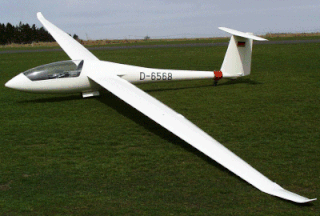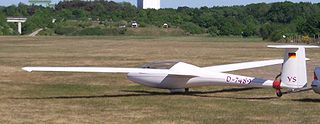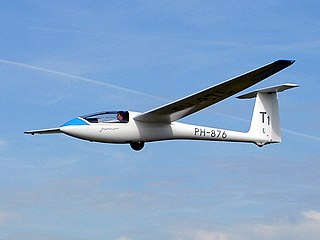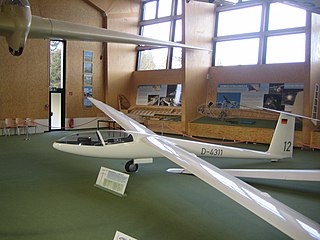Related Research Articles

The Schempp-Hirth Discus is a Standard Class glider designed by Schempp-Hirth. It was produced in Germany between 1984 and 1995 but has continued in production in the Czech Republic. It replaced the Standard Cirrus. It was designed by Klaus Holighaus.

The Schempp-Hirth Ventus is a sailplane produced during 1980–1994 by Schempp-Hirth, a German sailplane manufacturer. It was designed by Klaus Holighaus and replaced the Schempp-Hirth Mini-Nimbus. Schempp-Hirth manufactured 613 Ventus sailplanes.

The Glaser-Dirks DG-200 is a 15 metre class glider built by Glaser-Dirks, now DG Aviation GmbH

The Schempp-Hirth Mini Nimbus is a 15 Metre-class glider designed and built by Schempp-Hirth GmbH in the late 1970s.

The Schempp-Hirth Janus is a high performance two-seat glider that was built by Schempp-Hirth GmbH. It was the first high-performance two-seater.

The Standard Cirrus is a Standard-class glider built in Germany by Schempp-Hirth. The Standard Cirrus was produced between 1969 and 1985, when it was replaced by the Discus. Over 800 examples were built, making it one of the most successful early fibreglass glider designs.

The Schempp-Hirth Cirrus is an Open Class glider built by Schempp-Hirth between 1967 and 1971 and by VTC until 1977. It was replaced by the Nimbus 2.

The Schempp-Hirth Nimbus-2 is an Open Class glider built by Schempp-Hirth during the 1970s. The Nimbus-2 first flew in April 1971 and a total of over 240 examples of all subtypes have been built until the beginning of the 1980s. It replaced the Schempp-Hirth Cirrus.

The Schempp-Hirth Nimbus 3 is a glider built by Schempp-Hirth.

The Glasflügel 303 Mosquito is a composite 15 metre Class single-seat sailplane manufactured by Glasflügel between 1976 and 1980.
The Schleicher ASW 17 is a single-seat Open Class sailplane that was built by the German manufacturer Alexander Schleicher GmbH & Co and first flew in 1971. It replaced the ASW 12, and was replaced in 1981 by the ASW 22.

The VSO 10 Vosa is a Standard and Club-Class glider designed and manufactured in the Czechoslovak Republic from December 1978 as a replacement for the VT-116 Orlik II.
The ICA IS-32 is an open class high-performance metal two-seat sailplane produced in Romania in the 1970s. A refinement of the IS-28B, it shared most of that aircraft's fuselage, mated to new wings and empennage. This new wing had a span of 20 metres, featuring interconnected ailerons and flaps, Schempp-Hirth-type airbrakes. It had no provision for water ballast. The monowheel undercarriage differed from the IS-28 in being fully retractable.

The Glasflügel 604 is a high-wing, T-tailed, single seat, FAI Open Class glider that was designed and produced in West Germany by Glasflügel starting in 1970.

The Masak Scimitar was an American mid-wing, single-seat glider that was designed and constructed by Peter Masak. It first flew in 1995.

The PZL Bielsko SZD-51 Junior is a Polish single-seat training and club sailplane.

The LAK-12 is a Lithuanian mid-wing, single-seat, FAI Open Class glider that was designed and produced by Lietuviškos Aviacinės Konstrukcijos (LAK) in Lithuania and later by Sportine Aviacija and Sport Aviation USSR.

The Akaflieg Darmstadt D-36 Circe is a single seat, high performance sailplane designed and built in Germany in the mid-1960s, one of the early "glass ships". It was the winner at the German National Championships in 1964 and came second in the World Championships the following year.
The Akaflieg Braunschweig SB-8 is an experimental, single-seat, high performance glider built in Germany in the 1960s, constructed largely from glass fibre skin over built up balsa wood structure. Two were built; the second of which was later fitted with a high aspect ratio (30:1) wing, becoming the Akaflieg Braunschweig SB-9 Stratus.
The VFW-Fokker FK-3 is a single seat competition glider, built in Germany in the late 1960s. It had success at the Italian and Austrian national contests of 1968, resulting in a short production run the following year.
References
- 1 2 3 4 5 Simons, Martin (2005). Sailplanes 1965–2000 (2nd revised ed.). Königswinter: EQIP Werbung und Verlag G.m.b.H. pp. 143-147. ISBN 978-3-9808838-1-8.